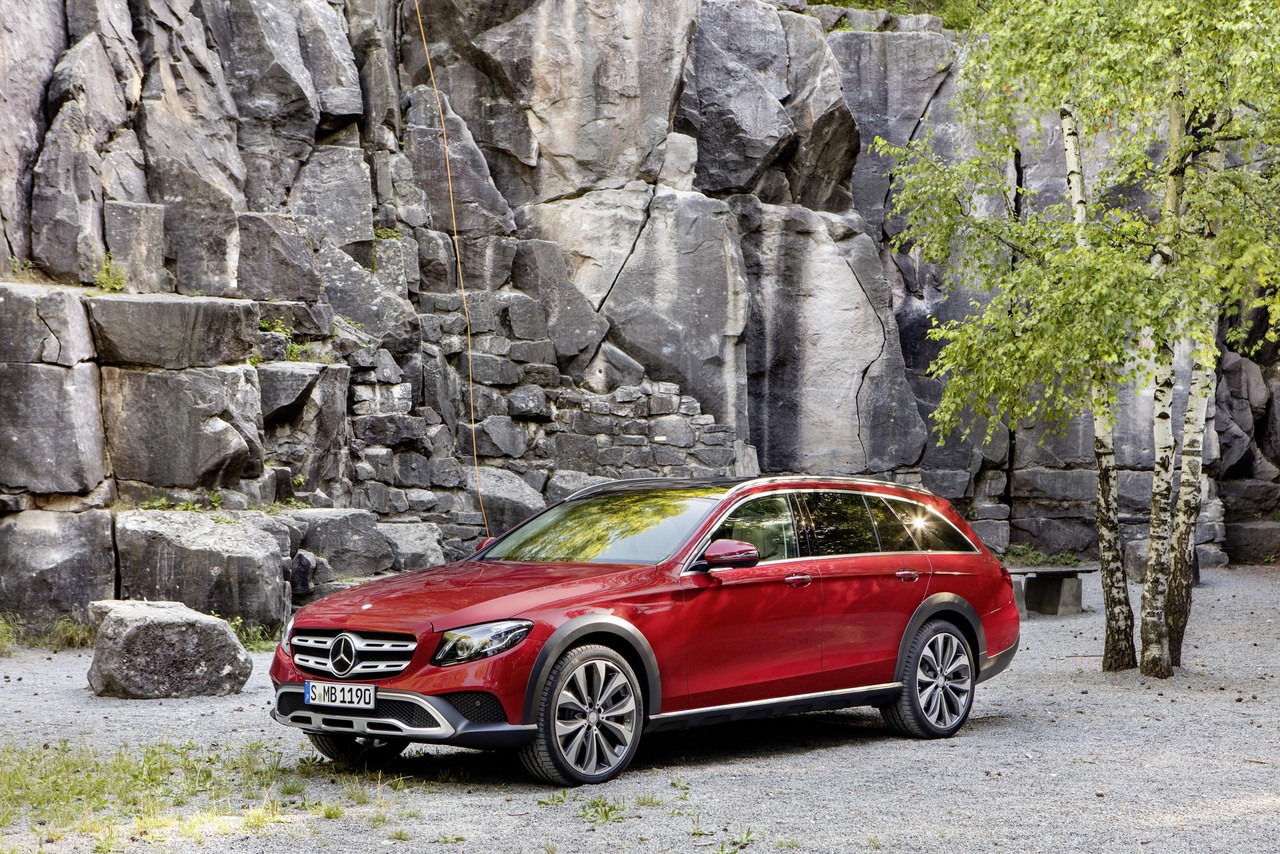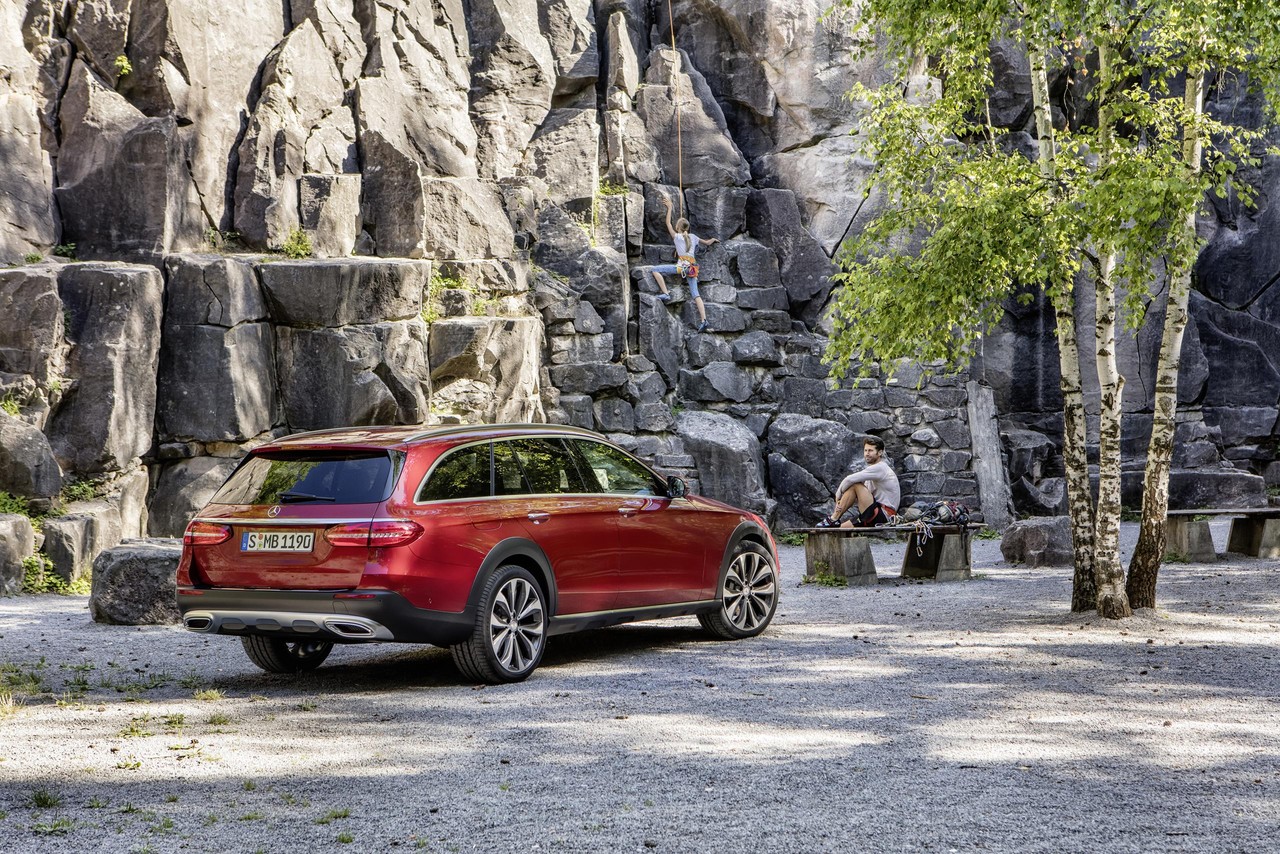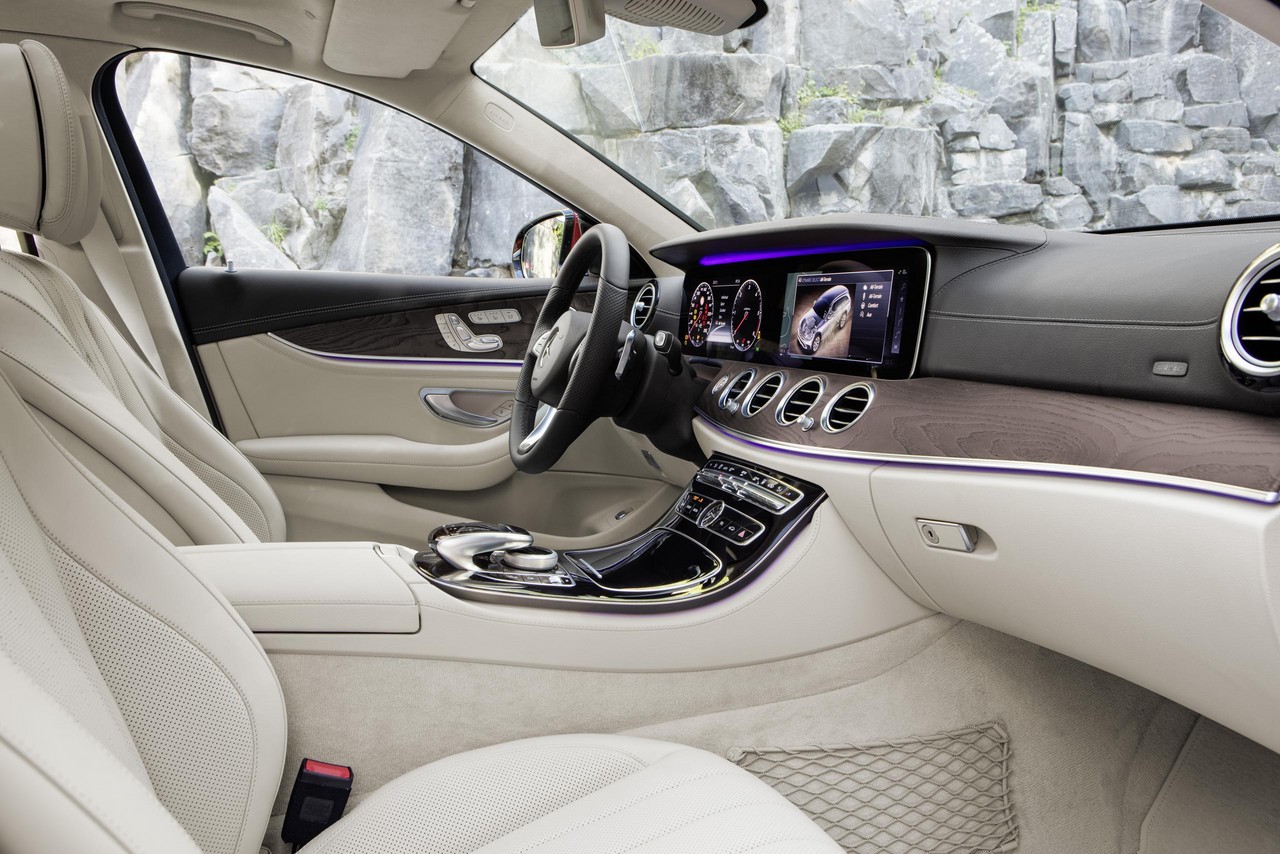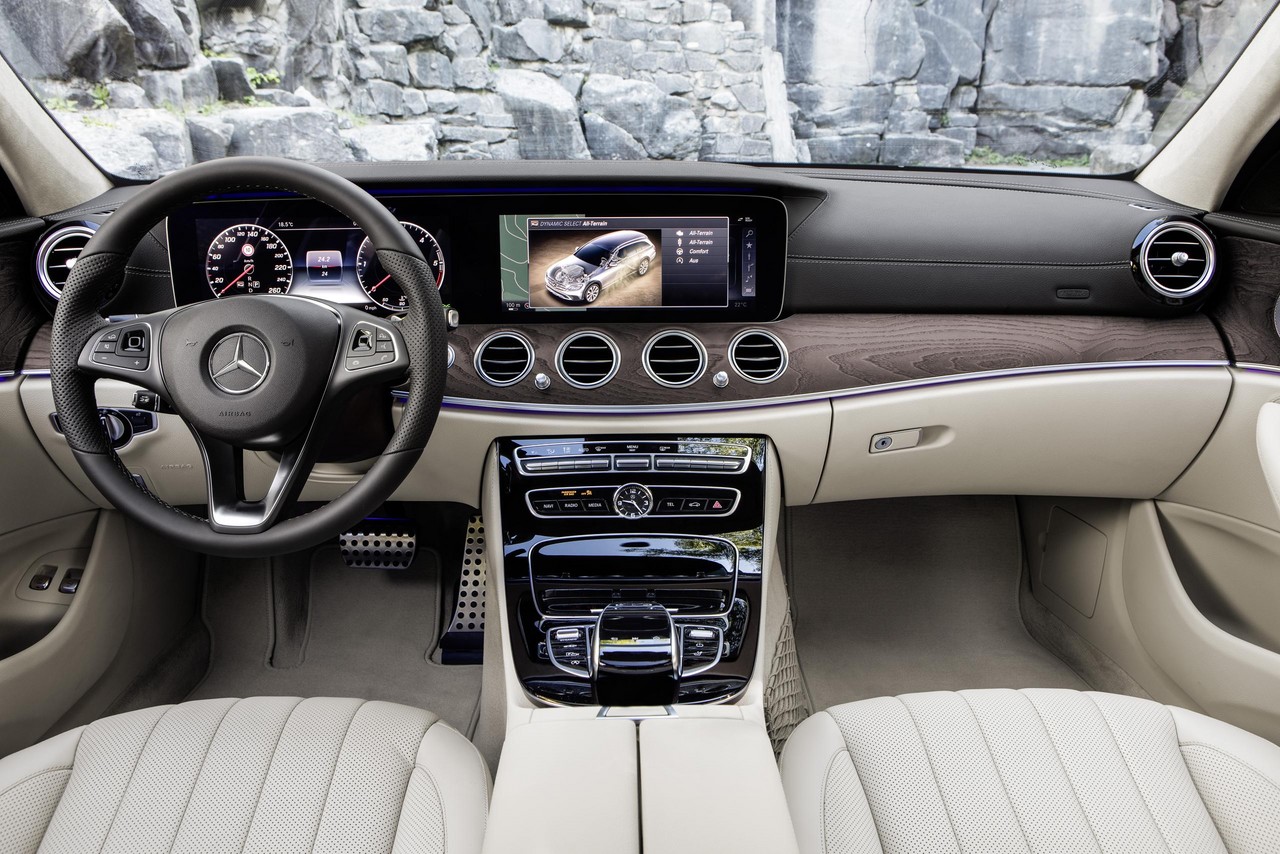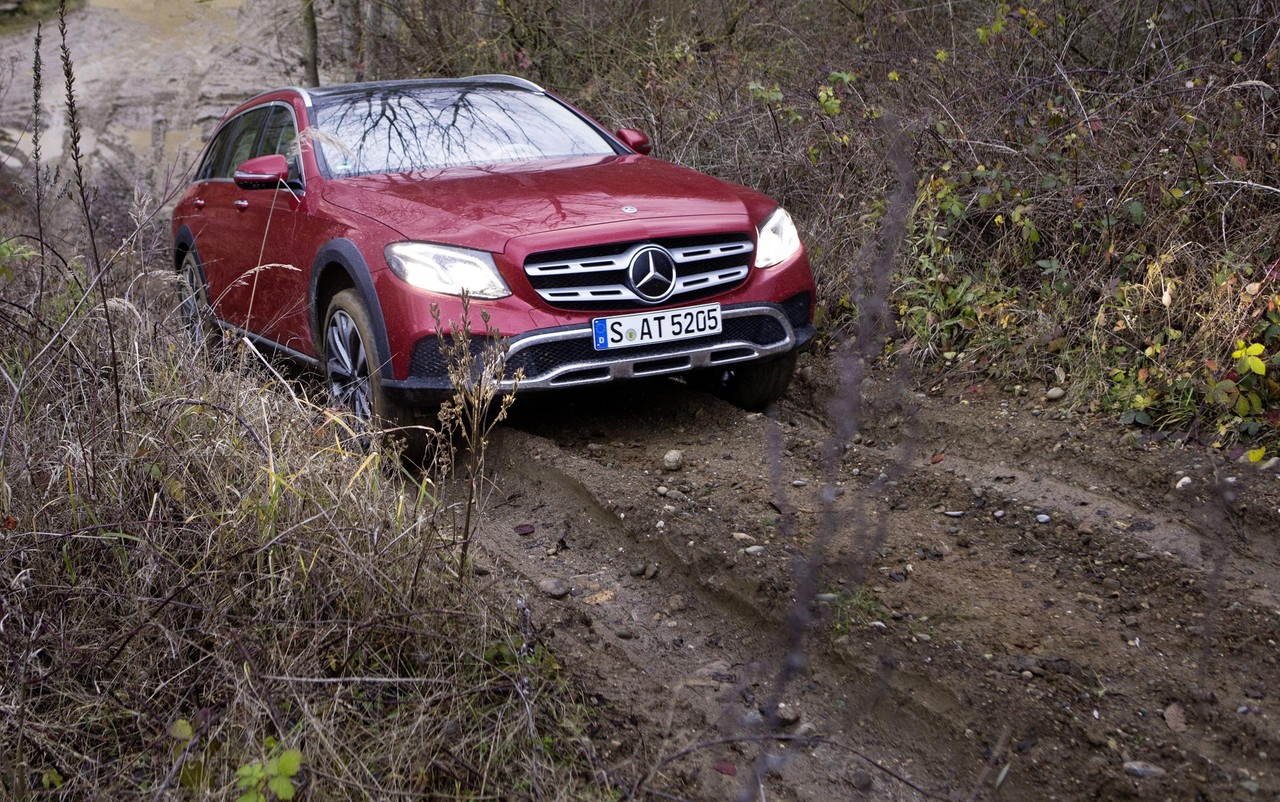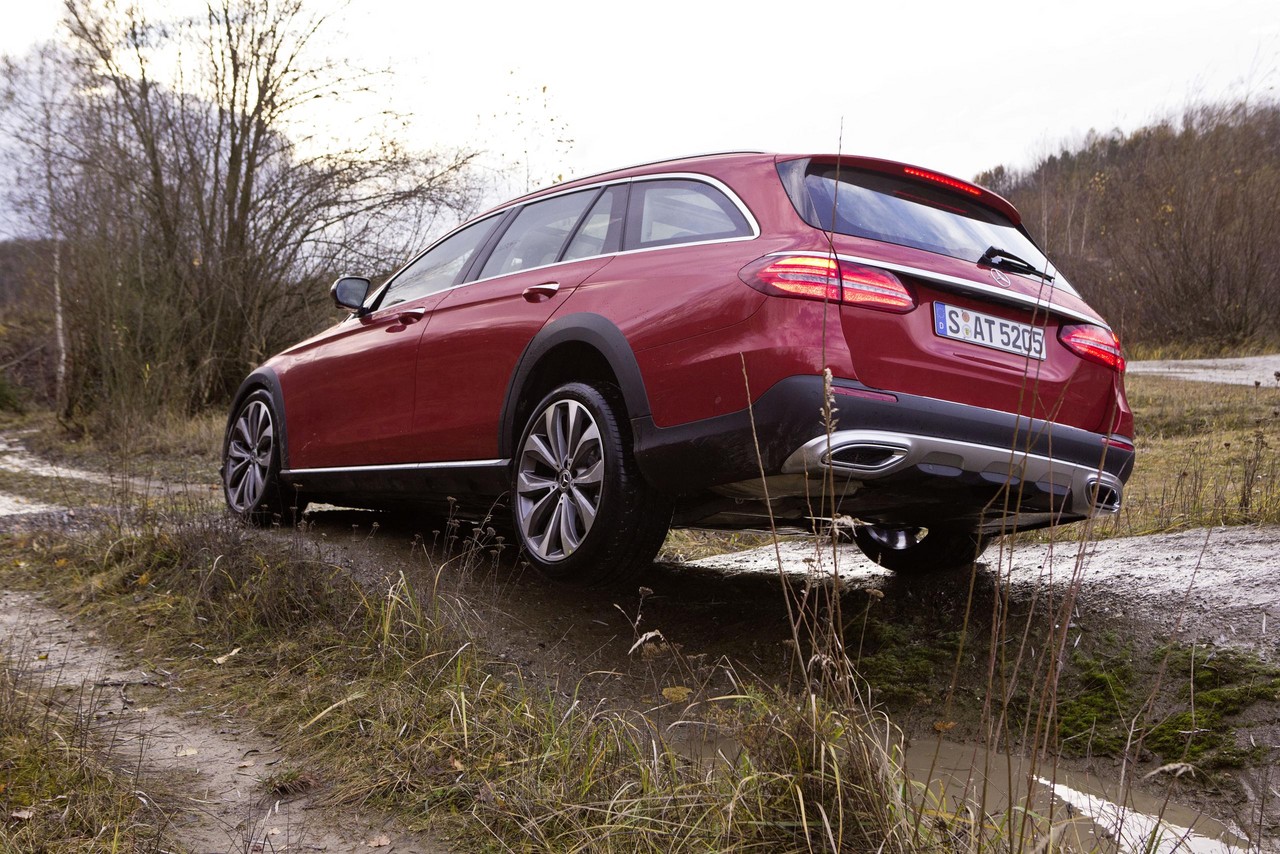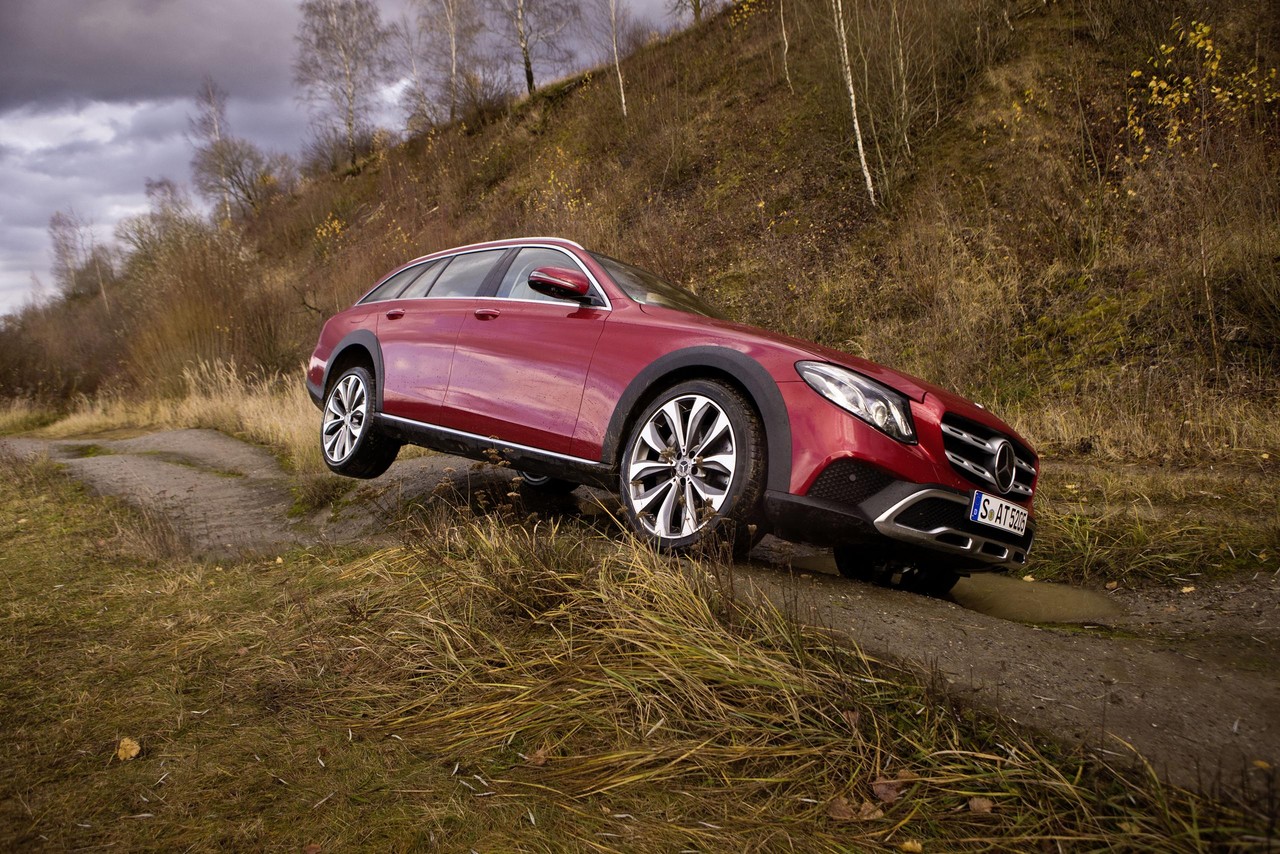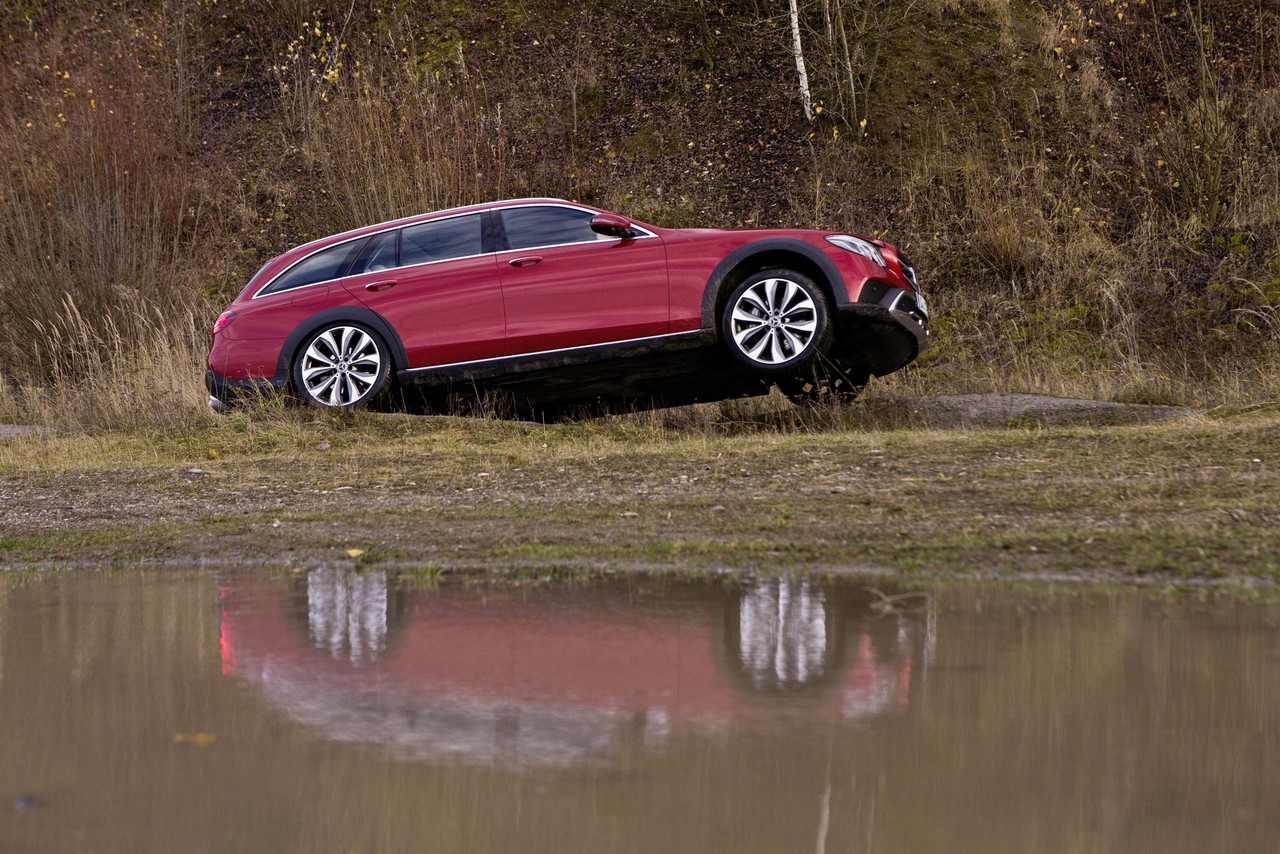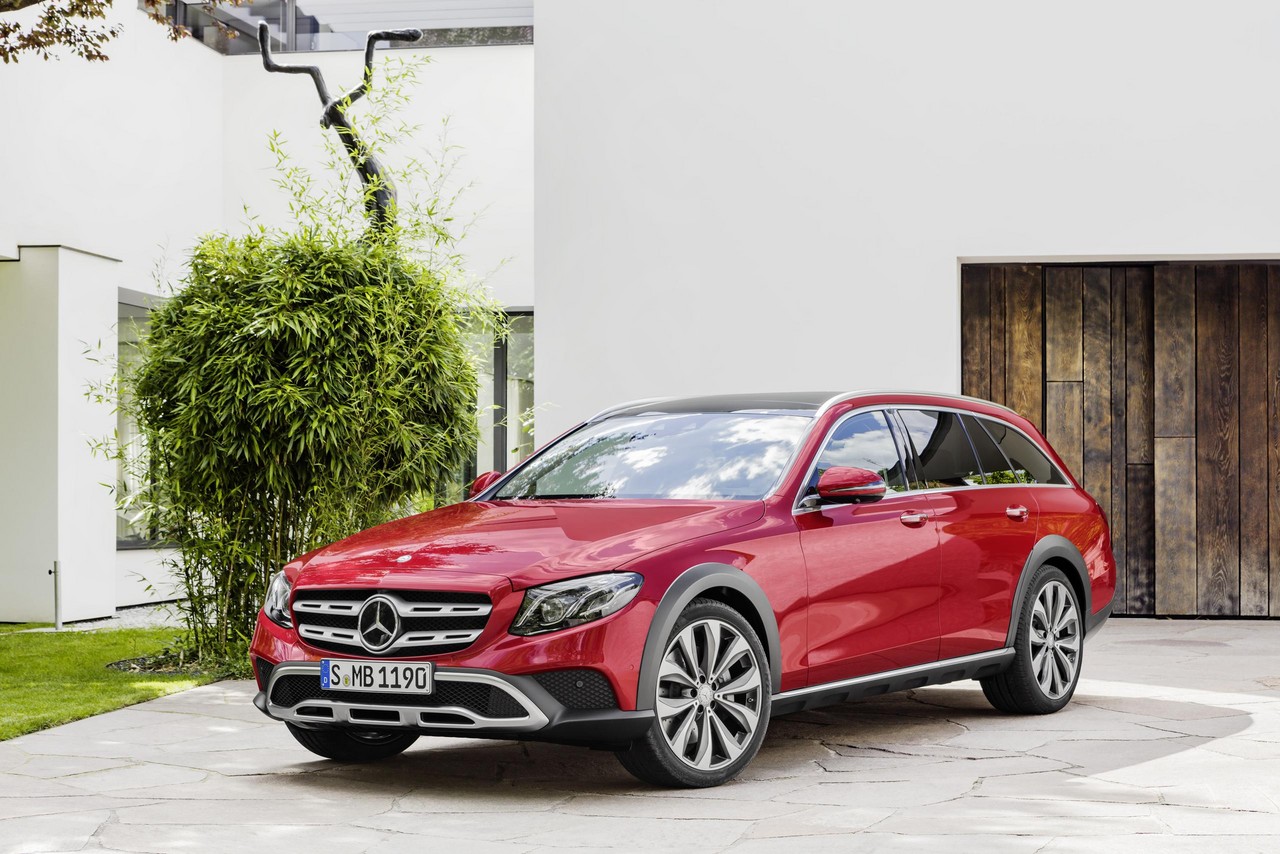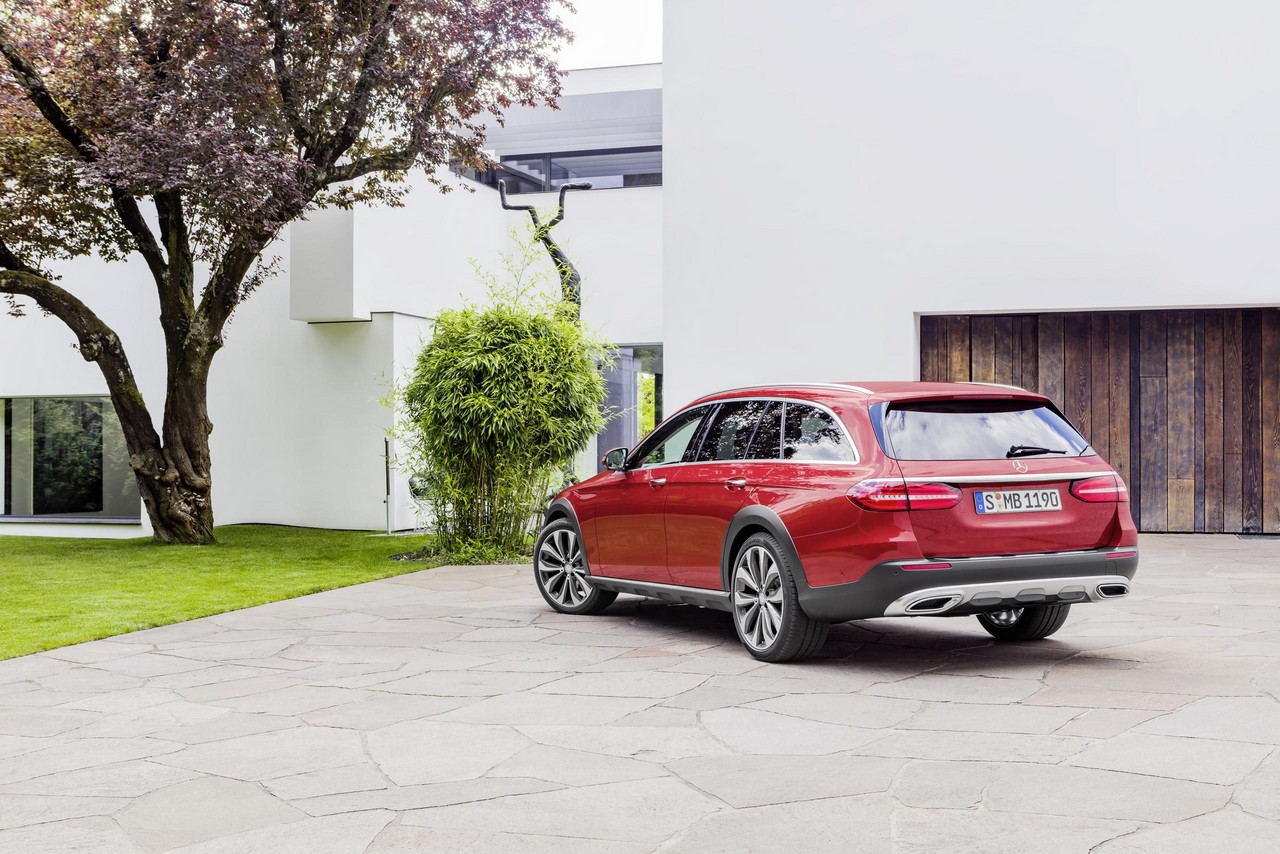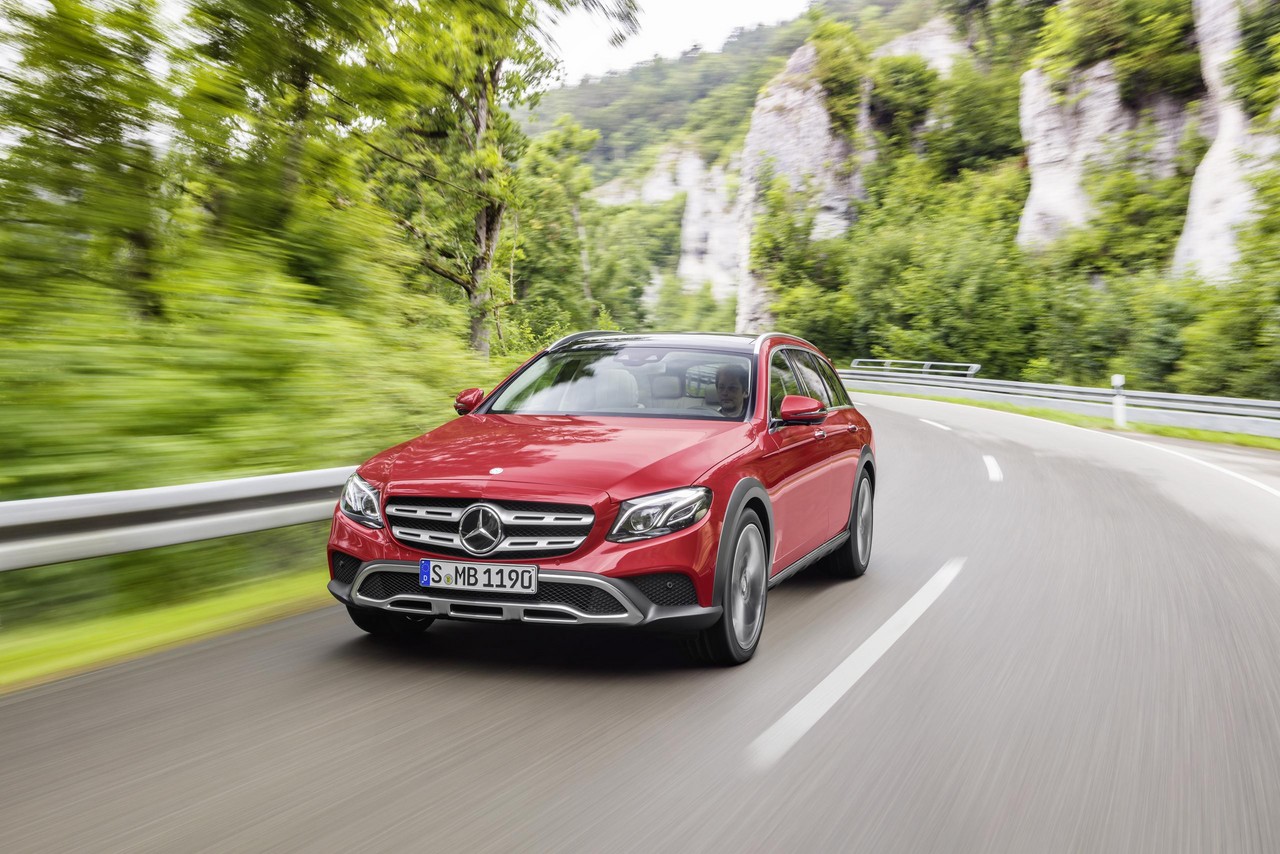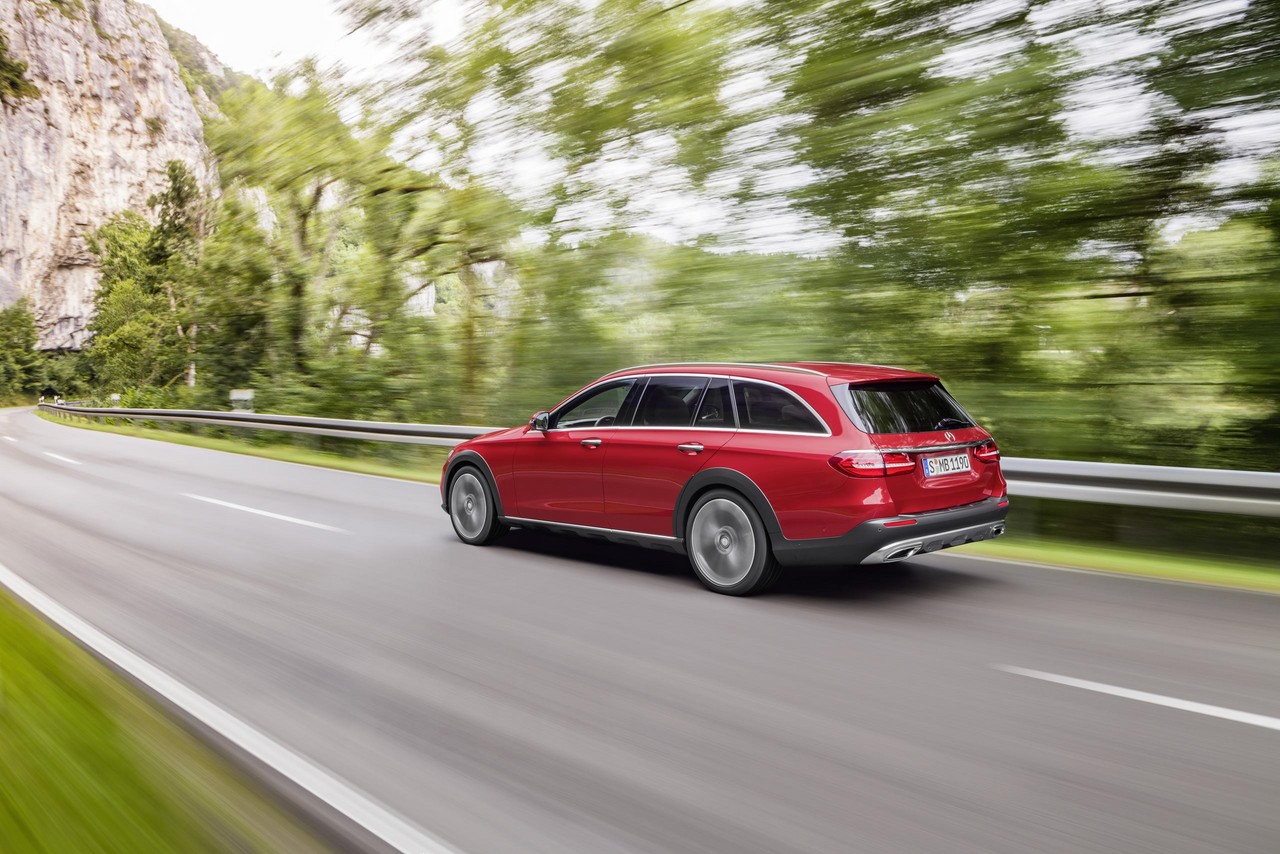
- Five star safety rating (for related W213 sedan )
- High standard of interior fit and finish
- Quiet, well-insulated cabin
- Comfortable ride
- Steering feedback?
- For E 220 d All-Terrain, diesel engine noise when pushed
Overview
Officially released in Australia in June 2017, the Mercedes-Benz S213 E-Class All-Terrain was an all-wheel drive wagon. Manufactured in Germany, the Mercedes-Benz E-Class All-Terrain was initially offered in an E 220 d 4MATIC model which had a manufacturer’s list price of $109,900 (excludes on-road costs).
To reduce fuel consumption, the Mercedes-Benz E 220 d 4MATIC All-Terrain had an ECO start/stop function that could shut down the engine when the vehicle was stationary in traffic to reduce fuel consumption. As part of its selective catalytic reduction system, the E 220 d 4MATIC had a 25 litre AdBlue tank.
| Model | Engine | Trans. | Peak power | Peak torque |
|---|---|---|---|---|
| E 220 d 4MATIC | 1950 cc OM654 turbo diesel I4 | 9sp auto | 143 kW at 3800 rpm | 400 Nm at 1600-2800 rpm |
4MATIC all-wheel drive system
The S213 E-Class All-Terrain was fitted with Mercedes-Benz’s ‘4MATIC’ all-wheel drive system. The transfer case for the 4MATIC system distributed torque in a default 45:55 front:rear split. If one or more wheels lost grip, however, the four-wheel traction system (‘4ETS’) would brake that wheel/s and automatically divert drive power to the wheels with traction.
The 4MATIC system also had a ‘pre-lock clutch’, a double-disc clutch which was fitted to the centre differential and provided a basic locking torque of approximately 50 Nm between the front and rear axles. The clutch pack was permanently pre-loaded via a plate spring and, in the event of a spinning wheel, friction torque was transmitted to the axle which rotated more slowly by relative movement of the discs. This ‘variable torque shift’ improved traction and directional stability.
For the E-Class All-Terrain, the transfer case was flange-mounted on the 9G-Tronic transmission whereas it had previously been integrated into the transmission. According to Mercedes-Benz, flange-mounting achieved a 3 kg mass reduction, reduced friction through better matching of lubricants, and the separate oil/hydraulic circuits reduced wear from impurities.
Body and dimensions
The Mercedes-Benz S213 E-Class All-Terrain shared its platform with the Mercedes-Benz W213 E-Class Sedan . Compared to the Mercedes-Benz S212 E-Class Estate , the S213 E-Class All-Terrain was 29 mm longer (at 4947 mm), 11 mm narrower (1861 mm), 15 mm lower (1497 mm) and had a 65 mm longer wheelbase (2939 mm). Furthermore, the E 220 d All-Terrain has a kerb weight of 1920 kg.
The S213 E-Class All-Terrain has a cargo volume of 670 litres (VDA method), though this increased to 1820 litres when the rear seat are folded flat and cargo is stored to the roofline.
Suspension
The Mercedes-Benz S213 E-Class All-Terrain had four-link front suspension and five-link rear suspension. As standard, Australian-delivered E-Class All-Terrain vehicles had ‘Air Body Control’ air suspension which consisted of three chambers of different size in the spring struts of the rear axle and two chambers in the spring struts of the front axle. ‘Air Body Control’ controlled how stiffly the suspension reacted in three stages, controlled ride height according to vehicle speed and provided a self-levelling function. Depending on its air suspension, ground clearance for the Mercedes-Benz E-Class All-Terrain could vary from 121 mm to 156 mm.
As an extra-cost option, the E-Class All-Terrain could be specified with ‘Dynamic Body Control’ adaptive damping for the front and rear axles. With Dynamic Body Control, damping forces for each wheel were adjusted to suit the driving situation and road condition.
Dynamic Select
The Mercedes-Benz S213 E-Class All-Terrain was equipped with ‘Dynamic Select’ which enabled the drive to select from five drive modes – Comfort, ECO, Sport, All-Terrain and Individual – that varied accelerator pedal response, operation of the ECO start/stop function, transmission shift points, suspension firmness, electronic stability control settings and steering assistance. In the ‘All-Terrain’ transmission mode, the suspension was also raised by 20 mm for speeds up to 35 km/h.
Steering
The Mercedes-Benz S213 E-Class All-Terrain had rack-and-pinion steering with electric power assistance; its turning circle was 11.9 metres.
Safety equipment
Standard safety equipment for the Mercedes-Benz S213 E-Class All-Terrain included dual front airbags, a driver’s knee airbag, front and rear side airbags, full-length curtain airbags, ABS, electronic brake force distribution, brake assist, electronic stability control, traction control and front seatbelts with pre-tensioners and load limiters.
For Australian deliveries, the Mercedes-Benz S213 E-Class All-Terrain was fitted with a ‘Driving Assistance package Plus’ which included –
- Drive Pilot: operated at speeds up to 210 km/h and could control the distance from the vehicle ahead, vehicle speed and steering via the following functions:
- Distance Pilot Distronic: adaptive cruise control that could maintain a safe distance from the vehicle ahead at speeds of up to 210 km/h and in stop/start traffic. An extended restart function also enabled automatic starting of the vehicle within 30 seconds after a stop that was initiated by Distance Pilot Distronic;
- Steering Pilot: used a camera to detect road markings and vehicles ahead so that Steering Pilot could follow those vehicles even on roads with several lanes or unclear road markings. Steering Pilot could also provide steering assistance for ‘moderate bends’;
- Active Emergency Stop Assist: if the driver removed their hands from the steering wheel, warnings were issued that directed the driver to grip the steering wheel. If the driver did not respond, Active Emergency Stop Assist would bring the vehicle to a standstill within its lane;
- Active Lane Change Assist: a radar- and camera-based system which operated at speeds between 80 km/h and 180 km/h. Active Lane Change Assist assisted the driver when changing lanes on multi-lane roads and could steer the vehicle into the lane selected by the driver. Once the driver has indicated to turn for at least two seconds, Active Lane Change Assist would steer the vehicle into the adjacent lane if it detected that the lane was unoccupied;
- Active Brake Assist with cross-traffic function: operated at speeds from 7 km/h to 250 km/h and used information from radar sensors and a stereo camera to warn of imminent collisions – visually and audibly – with vehicles or pedestrians ahead of the vehicle and provided autonomous braking. Beyond this, the cross-traffic function could detect crossing traffic at junctions and, if the driver failed to respond, applied the brakes autonomously. Furthermore, it could detect hazardous situations at the tail-end of traffic jams (where there was no room to manoeuvre) and initiate autonomous braking far sooner in such situations. Consequently, it was possible to avoid accidents at speeds up to 100 km/h or substantially reduce the severity of accidents at speeds above this level;
- Evasive Steering Assist: complemented the pedestrian detection function of Active Brake Assist. When the driver deliberately or instinctively performed an evasive manoeuvre in a dangerous situation, Evasive Steering Assist added ‘precisely calculated steering torque’ to support the movement of the steering wheel – this helped the driver to avoid the pedestrian in a controlled manner while helping to ‘straighten up’ the vehicle afterwards;
- Active Blind Spot Assist: active at speeds above 60 km/h, a corrective braking force was applied to the wheels on one side of the vehicle if the driver attempted to change lanes when a vehicle was detected in the driver’s blind spot;
- Active Lane Keeping Assist: initiated steering wheel vibrations if the vehicle approached a continuous lane marking line and, if crossed, automatically braked the wheels on one side of the vehicle to return the vehicle to its lane;
- Pre-Safe Plus: could anticipate rear-end collisions and warn following traffic by flashing the rear hazard warning lights at high frequency;
- Pre-Safe Impulse Side: if a lateral collision was imminent, Pre-Safe impulse side moved the driver or front passenger laterally away from the danger zone by inflating an air chamber in the side bolster of the front seat backrest nearest the side of the imminent impact – this action increased the distance between the occupant and door, thereby reducing the forces acting on the occupants;
- Attention Assist with adjustable sensitivity: operated at speeds in excess of 80 km/h and monitored driver behaviour and steering movements for signs of drowsiness; if detected, the driver was provided with visual and audible warnings; and,
- Crosswind Assist: could detect sudden, strong gusts of wind and prevent the vehicle from drifting out of its lane via corrective braking forces on one side of the vehicle.
As standard, the Mercedes-Benz S213 E-Class All-Terrain had an ‘active bonnet’ which, in the event of a pedestrian collision, initiated a pyrotechnic charge to raise the height of the bonnet and provide additional clearance to ‘hard points’ within the engine bay.
From September 2018, the Mercedes-Benz S213 E-Class All-Terrain was equipped with Traffic Sign Assist (TSA) which used navigation data and image recognition to display – in the instrument cluster – the maximum permitted speed, restrictions on overtaking and pedestrian warnings near ‘zebra’ crossings. Traffic Sign Assist also had an extended wrong-way warning, while the detection of stop signs was combined with the ECO start/stop function so that the engine remained on. Furthermore, Active Speed Limit Assist was a sub-function of Traffic Sign Assist that used the forward-facing camera to recognise sign gantries and road works signs to set the vehicle’s maximum speed.
Euro NCAP testing
In Euro NCAP testing , the related Mercedes-Benz W213 E-Class Sedan received a five star safety rating which included a 95 per cent adult occupant protection rating and a 90 per cent child occupant protection rating. In the frontal offset test, protection of the driver’s head, thighs and feet were rated as good, though chest and lower leg protection were rated as adequate (i.e. a slight risk of serious injury). Maximum points were awarded in the side impact test; in the more severe pole test, however, chest protection for the driver was rated as adequate.
Wheels, tyres and brakes
The Mercedes-Benz E 220 d 4MATIC All-Terrain had 20-inch five twin-spoke alloy wheels that were fitted with 8.5J x 20-inch 245/40 R20 front and 9.5J x 20-inch 275/35 R20 rear tyres. Furthermore, the Mercedes-Benz E 220 d 4MATIC All-Terrain had 330 mm by 32 mm ventilated front brake discs and 330 mm by 22 mm ventilated rear discs.
Features: Mercedes-Benz S213 E-Class All-Terrain
As standard, the Mercedes-Benz E 220 d 4MATIC All-Terrain was equipped with the COMAND Online Infotai Nment system which had a high-resolution display, digital radio tuner (DAB+), HDD navigation with 3D maps and dynamic route guidance, internet connectivity and smartphone integration via Android Auto or Apple CarPlay.
Additional standard features for the Mercedes-Benz E 220 d 4MATIC All-Terrain included ‘Thermatic’ dual-zone climate control air conditioning, , ‘Artico’ synthetic leather upholstery, power adjustable and heated front seats, multi-beam LED headlights with integral daytime running lights, dusk-sensing headlights, rain-sensing wipers, front and rear parking sensors, 40:20:40 split and folding rear seat backrests, a leather-wrapped steering wheel with gearshift paddles, power adjustable and heated door mirrors with folding function, power windows, a power adjustable steering wheel (for height and reach), memory settings (for the front seats and door mirrors), an auto-dimming rear-view mirror, push-button start, an electrically-operated park brake, illuminated door sills, ambient interior lighting, velour floor mats, a black roof liner, an analogue clock, cargo cover, rear privacy glass, aluminium roof rails, a 12 volt power socket, a tyre pressure loss indicator, a trip computer and an immobilizer.
As standard, the Mercedes-Benz E-Class All-Terrain was also fitted with:
- A rear view camera with dynamic guidelines;
- A 360 degree camera system which provided a bird’s eye view of the vehicle on the centre display and dynamic guidelines; and,
- Parking Pilot with Parking Assist: automatically engaged when driving at speeds up to 30 km/h, Parking Pilot could identify parallel and right angle parking spaces. Furthermore, the Parking Assist function could provide automated steering to manoeuvre the vehicle into the parking space while the driver controlled vehicle speed.
From September 2013, the Mercedes-Benz E-Class All-Terrain was fitted with new steering wheels that featured touch controls.
